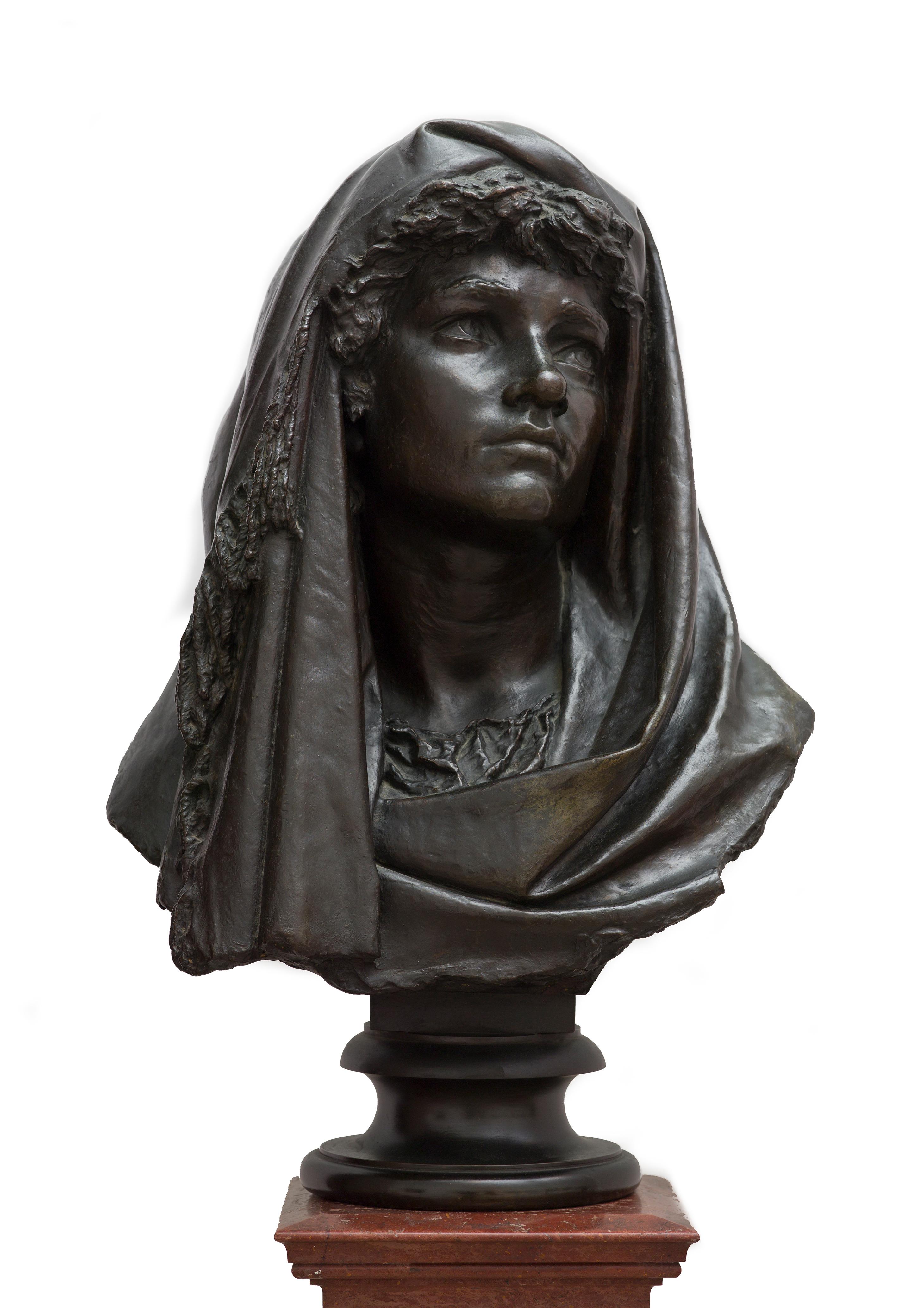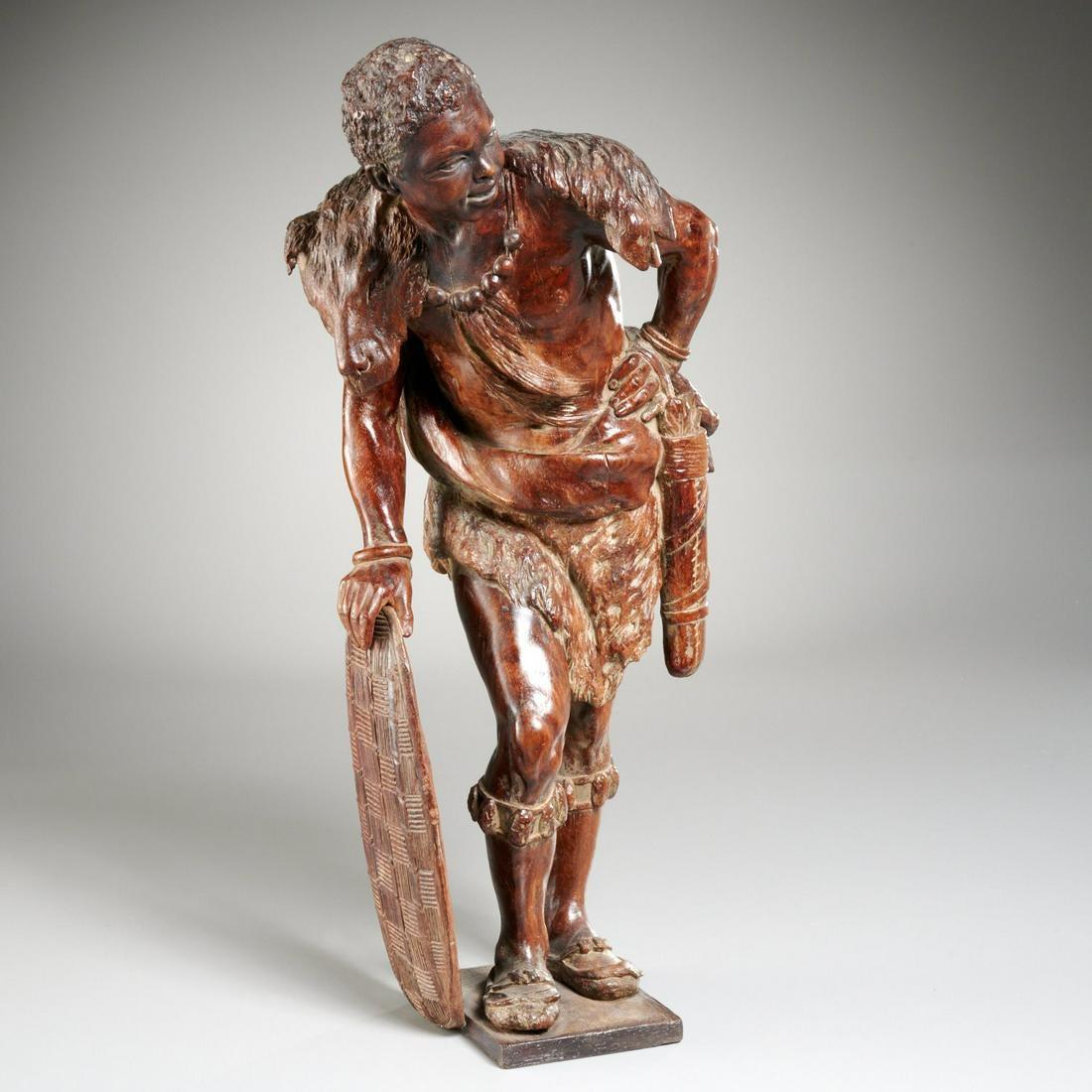Items Similar to Wolfgang Amadeus Mozart, 18th Century Half Length Sculpture
Want more images or videos?
Request additional images or videos from the seller
1 of 5
19th Century European SchoolWolfgang Amadeus Mozart, 18th Century Half Length Sculpture
About the Item
Plaster, raised pins and later coloured to simulate terracotta
Height: 32 3⁄4 inches (83.5 cm).
Full of elegance and liveliness, it conveys the consummate ability of the artist. Beautifully reinterpreting the portrait conventions inherited from eighteenth-century sculpture, Mozart is presented in a three-quarter view, his gaze turned. His wonderfully elaborate hair and the sweeping drapery reminds the viewer of the swagger of the previous century, as does the well-rendered folio and quill, giving the sitter a sensuous sophistication and conferring a sense of majesty appropriate of Mozart.
An exceptional, fine quality, mid-nineteenth century work, it bears nail heads and markings that apparently served as precise reference points for the sculptor. The nails are placed similar distances apart to determine the exact depth and spacing the sculptor needs to chisel.
Nails are visual tools that help sculptors achieve the correct dimensions for the sculpture.For sculptors to get accurate pointing on their sculptures and depict their subjects realistically, many points have to be used. This is especially true for complicated sculptures, like life-sized sculptures of people.
If a sculptor were to just start on a stone block first and mess up, they would need to start from scratch. The block of stone would potentially be wasted.
Once a plaster sculpture is completed, the dimensions are transferred from the plaster sculpture to the stone block with the pointing tool. The nail on the pointing tool is used as the pointer to get the reference distance so that depth is transferred correctly.
The pointing tool was perfected by the famous Italian sculptor Antonio Canova in the 1700s and used a nail as its main measurement mechanism.
Plaster sculptures save sculptors from destroying valuable stone sculpting material like marble.
- Creator:19th Century European School
- Dimensions:Height: 32 in (81.28 cm)Width: 15 in (38.1 cm)
- Medium:
- Movement & Style:
- Period:
- Condition:
- Gallery Location:London, GB
- Reference Number:1stDibs: LU52411937942
About the Seller
5.0
Vetted Seller
These experienced sellers undergo a comprehensive evaluation by our team of in-house experts.
Established in 2007
1stDibs seller since 2014
64 sales on 1stDibs
Typical response time: 4 hours
- ShippingRetrieving quote...Ships From: London, United Kingdom
- Return PolicyA return for this item may be initiated within 14 days of delivery.
More From This SellerView All
- Hand Carved Wooden Frame, 16th Century European SchoolLocated in London, GBHand Carved Fruit Wood Length: 16 inches (40.5 inches) A striking, richly hand carved frame in high relief. It shows a rich decor of natural organic forms alongside a collection of ...Category
16th Century Figurative Sculptures
MaterialsWood
- Wooden Maquette of a Leg, Hand Carved British SculptureLocated in London, GBHand-carved wooden trunk and plinth Height: 38 1/2 inches (98 cm) Width: 10 1/2 inches (27 cm) Lawson Rudge Lawson Rudge was born in 1936. He is...Category
20th Century Realist Figurative Sculptures
MaterialsWood
- Nude Statue, 20th Century Carved OakLocated in London, GBCarved Oak, 20th Century European School Nude Statue Height: 21 3/4 inchesCategory
20th Century Modern Figurative Sculptures
MaterialsOak
- Reclining Figure Carved Marble Early 20th Century FranceLocated in London, GBCircle of Henri-Gaudier-Breska 1891-1915 Reclining Figure Carved marble Height 5 inches Born Henri Alphonse Séraphin Marie Gaudier near Orléans in France, Gaudier-Brzeska started using his hyphenated name in 1910 when he met the Polish writer Sophie Brzeska. They moved to London together in January 1911 and adopted their new names and the identity of brother and sister in order to make their cohabitation respectable. Gaudier-Brzeska started to establish himself as a sculptor in 1912. Initially influenced heavily by Rodin, he later assimilated more influences from the modernist movement of cubism and from examples of non-European art he saw in London’s museums. He met the sculptor Jacob Epstein in June 1912, who further encouraged him to break with classical Greek tradition. While working from 25 Winthorpe Road in 1913–14, Gaudier-Brzeska became increasingly involved in London’s avant-garde art scene. He exhibited at the London Salon in July 1913, where he met the poet and arts patron Ezra Pound. Pound described Brzeska as ‘like a well-made young wolf or some soft-moving, bright-eyed wild thing’. Gaudier-Brzeska subsequently became associated with the vorticist movement led by Wyndham Lewis, contributing two important articles to Lewis’s magazine Blast and signing his name against the vorticist manifesto. He was also a founding member of the London Group, which formed when the all-male Camden Arts Group joined with independent artists to challenge the dominance of the Royal Academy of Arts. Other founding members included Walter Sickert, Robert Bevan and Spencer Gore...Category
Early 20th Century Figurative Sculptures
MaterialsMarble
- Bronze Head of a Young Boy, Early 20th Century English SculptureLocated in London, GBEnglish School Early 20th Century Head of a Young Boy Bronze with stone base Height: 12 3/4 inches (32.5 cm)Category
Early 20th Century Figurative Sculptures
MaterialsStone, Bronze
- Bust of Frederick William Walker, 19th Century Figurative SculptureLocated in London, GBHope-Pinker was born in Peckham, Surrey, the son of a stonemason and builder employing 5 or 6 men c.1871 in Hove, Sussex, who seems to have taught his son much of his stone-carving skills, although he also attended the Royal Academy Schools (c.1871). Hope-Pinker typically carved without a model from drawings. The bulk of his work was portrait sculpture and John Hunter...Category
19th Century English School Figurative Sculptures
MaterialsBronze
You May Also Like
- Statue of Athlete: Large Academic Style Bronze Figurative Sculpture of Nude MaleBy Mark BeardLocated in Hudson, NYmodern figurative bronze sculpture of a nude athlete 8.5 feet tall and measures 36 inches at the widest point bottom base measures ...Category
Early 2000s Academic Figurative Sculptures
MaterialsBronze
- Maiden with hatLocated in Roma, RMLuigi Preatoni (Novara 1845 - ?), Maiden with hat Marble bust 66 x 43 x 36 cm signed (L Preatoni) on edge of dress.Category
Late 19th Century Academic Figurative Sculptures
MaterialsMarble
- Bust of veiled womanLocated in Roma, RMGiulio Tadolini ( Rome 1849 - 1918 ) ( attr. to ), Bust of veiled woman Bronze 61 x 37 x 22 cm.Category
Late 19th Century Academic Figurative Sculptures
MaterialsBronze
- Baby, 1900-1920 - terracotta, 37x38x20 cmBy Max CantiniLocated in Nice, FRSculpture in terracotta.Category
Early 20th Century Academic Figurative Sculptures
MaterialsTerracotta
- Orientalist African Hunter Leaning on His Shield 19th cent. Black Forest, GermanLocated in SANTA FE, NMOrientalist African Hunter Leaning on His Shield Black Forest, School Switzerland 19th century Carved Wood 21 inches This is an exceptionally beautifu...Category
19th Century Academic Figurative Sculptures
MaterialsWood
- Ariane on Panther, Statue Alabaster, after J. H. Dannecker, end 19th cent.Located in PARIS, FR“Ariane on Panther” is the most worldwide known work of the German sculptor Johann Heinrich Dannecker, born 1758 and died 1841 in Stuttgart , pupil of Pajou and Canova. The original ...Category
1890s Academic Figurative Sculptures
MaterialsAlabaster
Recently Viewed
View AllMore Ways To Browse
Antique Sculpture
Antique Sculptures
Antique Sculpture Art Sculptures
Antique Figurative Sculptures
18th Century And 19th Century
Sculptures From 19th Century
19th Century Italian Art
19th Century Serve
4 Inch Sculpture
Antique European Sculpture
Hair Sculpture
Mid Century Antique Sculpture
18th Century Head
Mid Century Pin
Antique Marble Sculpture Art Sculptures
Mid Century Hair
Mid Century Stone Sculpture
Mid Century Block Art




